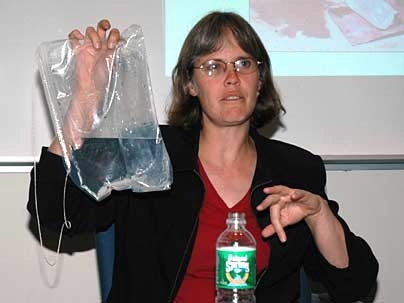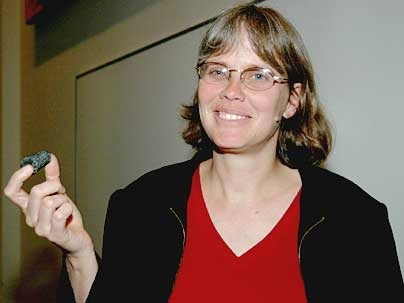"Appropriate technology" for developing nations can be as simple as a cloth sari folded four times and used to filter cholera bacteria from water. It can be as elegant as a clay pot within a pot that better preserves fresh vegetables or as disposable as a drip irrigation system used for one season.
The "appropriate technology" movement, while failing in some respects, has opened pathways for helping individuals gain better lives through simple, effective designs, said Amy Smith, a senior lecturer in mechanical engineering. She spoke May 7 during a spring colloquium hosted by the Program in Science, Technology and Society to explore "big questions."
"I think within the last decade we've redefined what is appropriate," said Smith before she proceeded to discuss or display a range of devices, from simple to complex.
In particular, appropriate technology has a new focus on helping people earn money from savings or efficiencies, said Smith, a MacArthur Fellowship recipient. The pot-in-a-pot, for example, allows farmers selling food at the market "to earn more money because they don't have to reduce the price of their crops at the end of the day because they'll still be good the next day." This is "a fabulous example of appropriate technology where a little bit of science and physics ends up creating a device that is very useful," she said.
An instructor at MIT's Edgerton Center, Smith co-founded the International Development Initiative, which provides MIT students with hands-on experience in community and development projects. She and her students work in poor nations to find design solutions that are inexpensive, use local materials and are culturally sensitive and relevant.
"The essence of really good design is embodied in these challenges," Smith said.
One example of such a challenge is the development of charcoal for use in deforested countries like Haiti. A press that compacts waste paper into briquettes was explored as option; however, Haitian villages have no waste paper and the paper used for experiments came from the Peace Corps office 200 miles away, Smith explained.
Smith's students developed ways to create charcoal from sugarcane and corncobs. "Turns out you can make a profit on this (corncob) charcoal in less than a week," Smith said. "It's a technology that will have a lot of impact, because of the economics, environment and health benefits--charcoal is a much cleaner-burning fuel than wood or cow dung."
Another design challenge is creating water purification systems. The organization Sodis (www.sodis.ch) has pioneered a solar water disinfection process in which water left in the sun in polyethylene bottles is quickly rid of bacteria through a combination of heat and ultraviolet rays. One of Smith's students improved on the Sodis container design by creating a clear bag that opens up to scoop river water, closes tightly to store for disinfection, sometimes in just two hours, and pours easily.
"This is a wonderful example of using an ingenious idea to create an extremely simple technology. Once you see it, you say, 'Oh yeah, why didn't they do that before,'" Smith said, adding as a vote of confidence, "We drink water from these things when we travel."
The student has patented the bag design, but in such a way that it can be distributed for free in Third World countries.
Smith also described working in Honduras to create a chlorination system that consisted of an IV drip, a toilet valve and a plastic bucket. The result, while effective, looked "like a piece of crap," and she started to think about how to make it sleeker. Then she realized that it should look junky and not intimidating--that would encourage people to keep it running with local materials. Indeed, she found on a subsequent visit that locals had improved the design and were teaching it to other communities.
However, such innovations, Smith insisted, do not eliminate the need for governments to provide clean water. Why should those who make $1 to $2 a day be required to purify their own water?, she questioned. The water purification bags are, she acknowledged, a "transition technology."
Smith also upturned the old saw about "teaching a man to fish" with these caveats: "Unless there's no river nearby"; "Until the fishing pole breaks"; and "Maybe you should ask if he likes fish."
A version of this article appeared in MIT Tech Talk on May 16, 2007 (download PDF).







